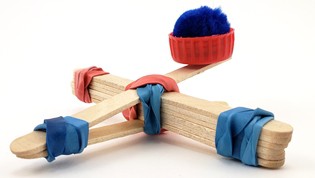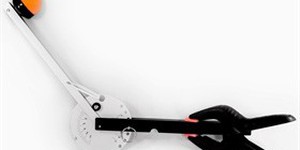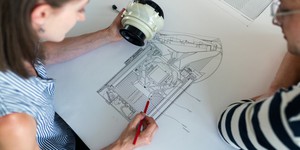Summary
Introduction
Catapults were mighty handy for pirates in the golden age of piracy (during the 17th century). And medieval knights used them centuries earlier for taking down massive castle walls. Even Greeks and Romans used catapults about 2,000 years ago! These simple machines are quite handy, as long as you know how to aim them! In this science activity you will try your hand at catapult technology. Can you predict where your cotton ball will land?
Materials
- Popsicle sticks (8)
- Rubber bands (at least 5)
- Glue
- Plastic bottle cap to hold a cotton ball
- Cotton ball (If you do not have any available, you can make a small ball by crumbling some paper.)
- Small open area (One square meter will do. It should be a sturdy, flat surface such as a table or floor.)
- Optional: markers to decorate your popsicle sticks
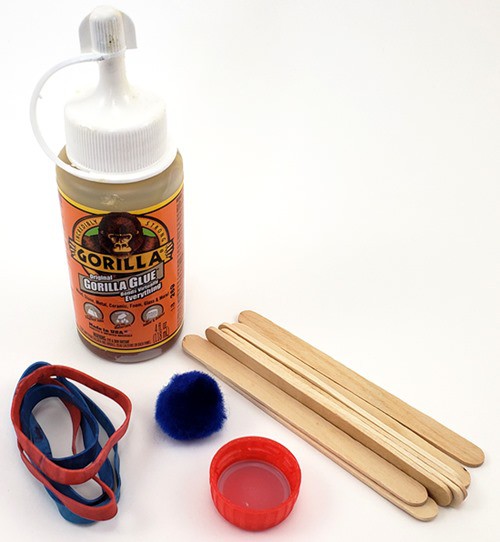 Image Credit: Ben Finio, Science Buddies / Science Buddies
Image Credit: Ben Finio, Science Buddies / Science Buddies
Prep Work
- Note: The simple catapult described in this project is safe when used with a cotton ball. Shooting hard objects or using other homemade catapults can be dangerous. Make sure any objects you launch are soft and light so as not to harm anyone or cause any damage to objects around you.
- Optional: use markers to decorate your popsicle sticks before you start.
- Take six craft sticks, stack them one on top of the other. Secure these sticks together by wrapping rubber bands around both ends of the stack. You will anchor the launching stick to this stack, as described in the next step.
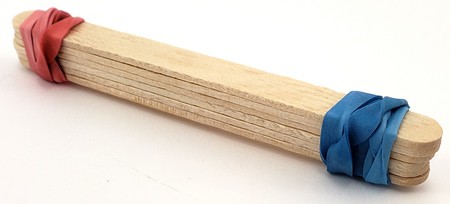 Image Credit: Ben Finio, Science Buddies / Science Buddies
Image Credit: Ben Finio, Science Buddies / Science Buddies
- To add the launching stick take one stick and attach it perpendicular to the stack you just made, around the middle, so you get a cross shape. You can do this with one or two rubber bands that are crossed in an X over the sticks. If you cross it this way, the sticks will stay nicely perpendicular.
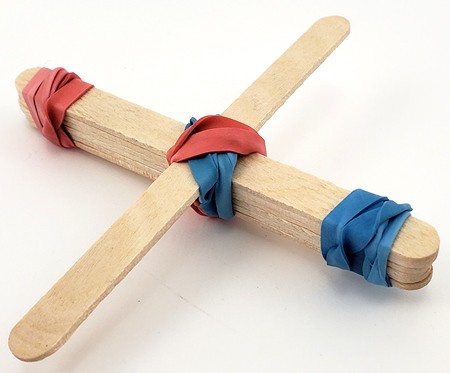 Image Credit: Ben Finio, Science Buddies / Science Buddies
Image Credit: Ben Finio, Science Buddies / Science Buddies
- Next, add the base by attaching a stick to one end of the launching stick with a rubber band. If it were not for the stack of sticks in between, the launching stick would fall flat on top of the base. Now the launching stick and the base form a V shape lying on its side with the stack of sticks in the middle.
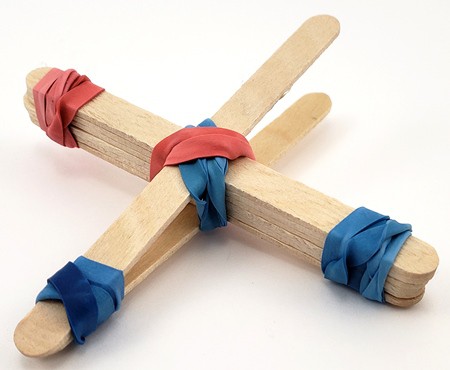 Image Credit: Ben Finio, Science Buddies / Science Buddies
Image Credit: Ben Finio, Science Buddies / Science Buddies
- Put your catapult on its base, locate the end of the launching stick that sticks up and glue the bottle cap there so it forms a small cup to hold the cotton ball.
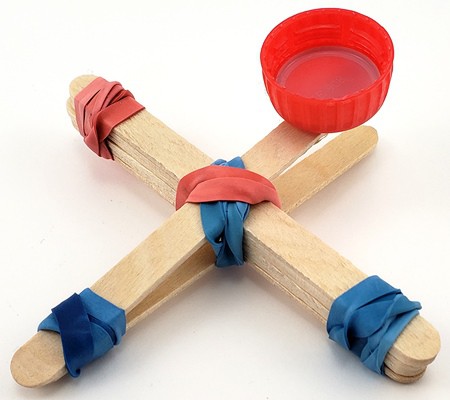 Image Credit: Ben Finio, Science Buddies / Science Buddies
Image Credit: Ben Finio, Science Buddies / Science Buddies
- Wait until the glue is dry.
Instructions
- Put your catapult in an open area with a sturdy, flat surface such as a table or an open space on a hard floor. Clear about a meter of open space for the cotton ball to fly and land.
- Place a cotton ball in the launching cup, push the cup down just a little bit and let go.What happened to the ball? Did it fly? Did it go high or low? Where did it land?What do you expect will happen when you push the cup farther down? Will this make it fly higher, farther, both higher and farther or take the same path but maybe faster?
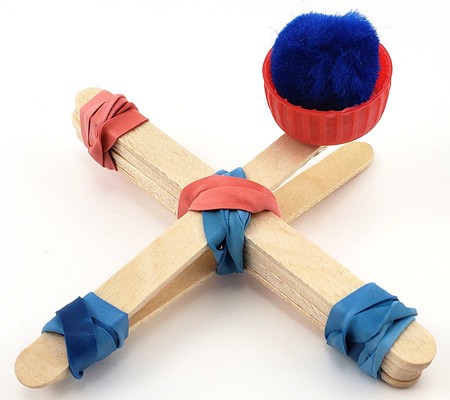 Image Credit: Ben Finio, Science Buddies / Science Buddies
Image Credit: Ben Finio, Science Buddies / Science Buddies
- Perform a test: Put your cotton ball in the cup, push the cup down farther, release and observe. You might need to repeat the test a few times to make your observations. It all happens fast!Does your ball fly higher or lower? Does it land farther or nearer when you push down a lot compared with when you push down a little?Did you notice in which case you needed to do the most work? Is it when you pushed down a little or when you pushed down farther?
- Try more launches.Do you get similar results each time? Is what you observe what you expected? Can you explain why?
What Happened?
Did you see your cotton ball fly higher and farther when you pushed you launching stick farther down?
When you bend your stick, you load your launching stick up with energy. When you let go, this energy is released and converted to energy of motion. Most of this energy transfers to the cotton ball, which shoots through the air.
Pushing the stick down farther takes more effort from you. Maybe you felt you needed to exert more force or work harder to bend the stick farther. Bending farther means more energy gets stored in the stick, and when you let go, all this stored energy is converted into energy of motion, so the cotton ball flies through the air at a higher speed. In the case of your catapult, the cotton ball probably flew higher and farther.
Moving the stack of six sticks closer to the launching cup makes the launching stick lie flatter. This results in a cotton ball aimed more upward than forward. Pushing your six sticks the other direction creates a greater angle between the launching stick and the base. This helps you aim the cotton ball forward.
Digging Deeper
A catapult works because energy can be converted from one type to another and transferred from one object to another. When you prepare the catapult to launch, you add energy to it. This energy is stored in the launching device as potential, or stored, energy. The catapult you are about to make uses elastic potential energy* stored in a wooden stick as you bend it. When you let go, this stored energy is released, converted into energy of motion (kinetic energy) and transferred to the cotton ball, which then flies through the air.
*There are other types of potential energy, like gravitational potential energy—the stored energy an object has due to its height off the ground.
Ask an Expert
For Further Exploration
- Test what happens if you move the stack of six sticks closer to the launching cup or in the other direction. This will change the position of the launching stick when the missile becomes airborne. How do you think your change will affect the ball's flight path?
- Build several catapults and play a game with your friends. Use a leftover bottle cap as a target. Place the catapults in a circle about 60 centimeters away from the cup and see who can score the most goals. Make the circle bigger and see who can adjust their launching technique to best fit the new conditions.


